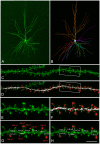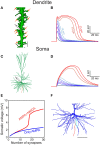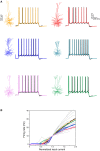Human Cortical Pyramidal Neurons: From Spines to Spikes via Models
- PMID: 30008663
- PMCID: PMC6034553
- DOI: 10.3389/fncel.2018.00181
Human Cortical Pyramidal Neurons: From Spines to Spikes via Models
Abstract
We present detailed models of pyramidal cells from human neocortex, including models on their excitatory synapses, dendritic spines, dendritic NMDA- and somatic/axonal Na+ spikes that provided new insights into signal processing and computational capabilities of these principal cells. Six human layer 2 and layer 3 pyramidal cells (HL2/L3 PCs) were modeled, integrating detailed anatomical and physiological data from both fresh and postmortem tissues from human temporal cortex. The models predicted particularly large AMPA- and NMDA-conductances per synaptic contact (0.88 and 1.31 nS, respectively) and a steep dependence of the NMDA-conductance on voltage. These estimates were based on intracellular recordings from synaptically-connected HL2/L3 pairs, combined with extra-cellular current injections and use of synaptic blockers, and the assumption of five contacts per synaptic connection. A large dataset of high-resolution reconstructed HL2/L3 dendritic spines provided estimates for the EPSPs at the spine head (12.7 ± 4.6 mV), spine base (9.7 ± 5.0 mV), and soma (0.3 ± 0.1 mV), and for the spine neck resistance (50-80 MΩ). Matching the shape and firing pattern of experimental somatic Na+-spikes provided estimates for the density of the somatic/axonal excitable membrane ion channels, predicting that 134 ± 28 simultaneously activated HL2/L3-HL2/L3 synapses are required for generating (with 50% probability) a somatic Na+ spike. Dendritic NMDA spikes were triggered in the model when 20 ± 10 excitatory spinous synapses were simultaneously activated on individual dendritic branches. The particularly large number of basal dendrites in HL2/L3 PCs and the distinctive cable elongation of their terminals imply that ~25 NMDA-spikes could be generated independently and simultaneously in these cells, as compared to ~14 in L2/3 PCs from the rat somatosensory cortex. These multi-sites non-linear signals, together with the large (~30,000) excitatory synapses/cell, equip human L2/L3 PCs with enhanced computational capabilities. Our study provides the most comprehensive model of any human neuron to-date demonstrating the biophysical and computational distinctiveness of human cortical neurons.
Keywords: compartmental modeling; cortical excitatory synapses; dendritic spines; human pyramidal cells; multi objective optimization; neuron computation; non-linear dendrites.
Figures









Similar articles
-
Comprehensive Morpho-Electrotonic Analysis Shows 2 Distinct Classes of L2 and L3 Pyramidal Neurons in Human Temporal Cortex.Cereb Cortex. 2017 Nov 1;27(11):5398-5414. doi: 10.1093/cercor/bhx226. Cereb Cortex. 2017. PMID: 28968789 Free PMC article.
-
Physiology and anatomy of synaptic connections between thick tufted pyramidal neurones in the developing rat neocortex.J Physiol. 1997 Apr 15;500 ( Pt 2)(Pt 2):409-40. doi: 10.1113/jphysiol.1997.sp022031. J Physiol. 1997. PMID: 9147328 Free PMC article.
-
Factors determining the efficacy of distal excitatory synapses in rat hippocampal CA1 pyramidal neurones.J Physiol. 1998 Mar 1;507 ( Pt 2)(Pt 2):441-62. doi: 10.1111/j.1469-7793.1998.441bt.x. J Physiol. 1998. PMID: 9518704 Free PMC article.
-
The integrative properties of spiny distal dendrites.Neuroscience. 1992;47(3):495-519. doi: 10.1016/0306-4522(92)90161-t. Neuroscience. 1992. PMID: 1584406 Review.
-
Electrically coupled but chemically isolated synapses: dendritic spines and calcium in a rule for synaptic modification.Prog Neurobiol. 1988;31(6):507-28. doi: 10.1016/0301-0082(88)90013-5. Prog Neurobiol. 1988. PMID: 2849143 Review.
Cited by
-
Traces of semantization - from episodic to semantic memory in a spiking cortical network model.eNeuro. 2022 Jul 8;9(4):ENEURO.0062-22.2022. doi: 10.1523/ENEURO.0062-22.2022. Online ahead of print. eNeuro. 2022. PMID: 35803714 Free PMC article.
-
Genetic Mechanisms Underlying the Evolution of Connectivity in the Human Cortex.Front Neural Circuits. 2022 Jan 7;15:787164. doi: 10.3389/fncir.2021.787164. eCollection 2021. Front Neural Circuits. 2022. PMID: 35069126 Free PMC article. Review.
-
Cell type-specific gene expression dynamics during human brain maturation.bioRxiv [Preprint]. 2024 May 17:2023.09.29.560114. doi: 10.1101/2023.09.29.560114. bioRxiv. 2024. Update in: Nat Genet. 2024 Dec;56(12):2718-2730. doi: 10.1038/s41588-024-01990-6. PMID: 37808657 Free PMC article. Updated. Preprint.
-
What makes human cortical pyramidal neurons functionally complex.bioRxiv [Preprint]. 2024 Dec 19:2024.12.17.628883. doi: 10.1101/2024.12.17.628883. bioRxiv. 2024. PMID: 39763809 Free PMC article. Preprint.
-
Principles for Dendritic Spine Size and Density in Human and Mouse Cortical Pyramidal Neurons.J Comp Neurol. 2025 Jun;533(6):e70060. doi: 10.1002/cne.70060. J Comp Neurol. 2025. PMID: 40421877 Free PMC article.
References
Grants and funding
LinkOut - more resources
Full Text Sources
Other Literature Sources
Molecular Biology Databases
Miscellaneous

